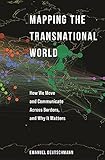Mapping the Transnational World : How We Move and Communicate across Borders, and Why It Matters / Emanuel Deutschmann.
Material type: TextSeries: Princeton Studies in Global and Comparative SociologyPublisher: Princeton, NJ : Princeton University Press, [2022]Copyright date: ©2021Description: 1 online resource (272 p.) : 5 color + 29 b/w illus. 16 tables. 3 mapsContent type:
TextSeries: Princeton Studies in Global and Comparative SociologyPublisher: Princeton, NJ : Princeton University Press, [2022]Copyright date: ©2021Description: 1 online resource (272 p.) : 5 color + 29 b/w illus. 16 tables. 3 mapsContent type: - 9780691226507
- SOCIAL SCIENCE / Sociology / General
- Analytical sociology
- Anthropocentrism
- Border Region
- Border control
- Border
- Capitalism
- Case study
- Central America
- Central Asia
- City-state
- Civilization
- Clustering coefficient
- Comparative Study
- Comparative advantage
- Comparative research
- Comparative sociology
- Conceptualization (information science)
- Consumerism
- Contact hypothesis
- Cosmopolitanism
- Critical geography
- Currency
- Dynamic density
- Economic union
- Epistemology
- European Commission
- European integration
- Explanation
- Explanatory power
- Finding
- Fortress Europe
- Global citizenship
- Global governance
- Global justice movement
- Globalism
- Globalization
- Historical region
- Human behavior
- Human capital flight
- Illustration
- Imagery
- Instance (computer science)
- Institution
- Intergovernmental organization
- International Networks (country code)
- International Social Survey Programme
- International communication
- International community
- International organization
- International relations
- International trade
- Latin America
- Level of analysis
- Make A Difference
- Map projection
- Marxism
- Mercosur
- Migration studies
- Modernization theory
- Nation state
- Naturalization
- North America
- Oceania
- Organization
- Phenomenon
- Political science
- Power law
- Product market
- Quantity
- Refugee
- Regional integration
- Remittance
- Search engine optimization
- Social constructionism
- Social integration
- Social relation
- Social research
- Social science
- Social theory
- Society
- Sociology
- Southeast Asia
- Spatial scale
- Statista
- Structural pattern
- Technology
- Theory
- Tourism
- Transdisciplinarity
- Transnational governance
- Transnationalism
- Travel agency
- Universalization
- Urban sociology
- Workspace
- World Polity Theory
- World Tourism Organization
- World population
- World-system
- World-systems theory
- online - DeGruyter
| Item type | Current library | Call number | URL | Status | Notes | Barcode | |
|---|---|---|---|---|---|---|---|
 eBook
eBook
|
Biblioteca "Angelicum" Pont. Univ. S.Tommaso d'Aquino Nuvola online | online - DeGruyter (Browse shelf(Opens below)) | Online access | Not for loan (Accesso limitato) | Accesso per gli utenti autorizzati / Access for authorized users | (dgr)9780691226507 |
Frontmatter -- Summary of Contents -- Contents -- Acknowledgments -- List of Abbreviations -- 1 Entering the Transnational World -- 2. Four Paths toward a Comparative Sociology of Regional Integration -- 3. The Regionalized Structure of Transnational Human Activity, 1960–2010 -- 4. Why Does Regionalism Occur in Transnational Human Activity? -- 5.The Spatial Structure of Transnational Human Activity -- 6. Lessons: Mobilization, Not Globalization -- Appendix -- Notes -- References -- Index
restricted access online access with authorization star
http://purl.org/coar/access_right/c_16ec
A study in the structure, growth, and future of transnational human travel and communicationDuring the past decades, humanity has become more transnationally active. Increasingly, people travel and communicate across borders. Yet, we still know little about the overall structure of this transnational world. Is it really a fully globalized world in which everything is linked, as popular catchphrases like “global village” suggest? Through a sweeping comparative analysis of eight types of mobility and communication among countries worldwide—from migration and tourism to Facebook friendships and phone calls—Mapping the Transnational World demonstrates that our behavior is actually regionalized, not globalized.Emanuel Deutschmann shows that transnational activity within world regions is not so much the outcome of political, cultural, or economic factors, but driven primarily by geographic distance. He explains that the spatial structure of transnational human activity follows a simple mathematical function, the power law, a pattern that also fits the movements of many other animal species on this planet. Moreover, this pattern remains extremely stable during the five decades studied—1960 to 2010. Unveiling proximity-induced regionalism as a major feature of planet-scale networks of transnational human activity, Deutschmann provides a crucial corrective to several fields of research.Revealing why a truly global society is unlikely to emerge, Mapping the Transnational World highlights the essential role of interaction beyond borders on a planet that remains spatially fragmented.
Mode of access: Internet via World Wide Web.
In English.
Description based on online resource; title from PDF title page (publisher's Web site, viewed 01. Dez 2022)


